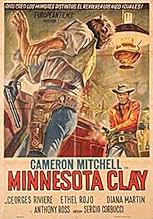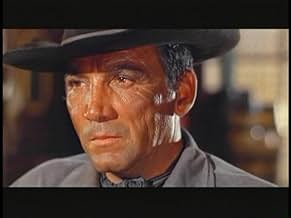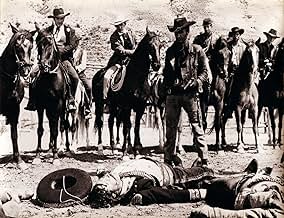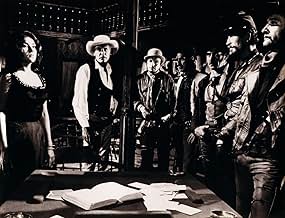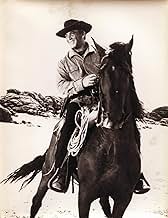NOTE IMDb
6,0/10
1 k
MA NOTE
Ajouter une intrigue dans votre langueWrongfully imprisoned for a crime he did not commit, Minnesota Clay seeks revenge on the man who withheld evidence at his trial. The catch: he is going blind.Wrongfully imprisoned for a crime he did not commit, Minnesota Clay seeks revenge on the man who withheld evidence at his trial. The catch: he is going blind.Wrongfully imprisoned for a crime he did not commit, Minnesota Clay seeks revenge on the man who withheld evidence at his trial. The catch: he is going blind.
- Réalisation
- Scénario
- Casting principal
Georges Rivière
- Fox
- (as Georges Riviere)
Diana Martín
- Nancy Mulligan
- (as Diana Martin)
Antonio Roso
- Mudo
- (as Anthony Ross)
Ferdinando Poggi
- Tubbs
- (as Nando Poggi)
Julio Peña
- Doctor Stevens
- (as Jiulio Peña)
Filippo Antonelli
- Fox Henchman
- (non crédité)
Simón Arriaga
- Ortiz Henchman
- (non crédité)
Alberto Cevenini
- Andy
- (non crédité)
Avis à la une
As a huge lover of Italian Westerns, Sergio Corbucci is one of my favorite directors ever. Corbucci's most famous and influential film is doubtlessly the blood-soaked cult-flick "Django" of 1966, his most brilliant achievement is the dark 1968 masterpiece "Il Grande Silenzio" ("The Great Silence"). But Corbucci enriched the Spaghetti-Western genre by even more masterpieces than the aforementioned two films, such as the Mexican revolutionary Westerns "Il Mercenario" (aka. "The Mercenary", 1968) and "Vamos A Matar, Compañeros" (1970). And even his lesser known films, such as "I Crudeli" ("Hellbenders", 1967) or "Navajo Joe" (1966) stand out as gritty and great Spaghetti Westerns, which makes Corbucci the undisputed number 2 in the genre, right after Sergio Leone. This being said, Corbucci's early Western "Minesota Clay" of 1965 does not live up to his later films in the Genre. While this is by no means a bad film, it is nowhere near as cynical, gritty and memorable as Corbucci's later Westerns were, as it bears more resemblance to the traditional American 'Good Guys Vs. Bad Guys' Westerns than the masterpieces of Corbucci's later career.
The eponymous hero, Minnesota Clay (played by the great Cameron Mitchell) is not really a typical anti-hero, as he is looking partly for revenge, but mainly for justice and for an opportunity to redeem his name. The two rivaling gangs (Mexican vs. American) that control the little town where this is set resemble the premise of "Django" as well as Leone's milestone "Fistful Of Dollars" (both of which were based on Akira Kurosawa's masterpiece "Yojimbo"). Yet, "Minnesota Clay" can not nearly make as much of it as "Fistful..." and "Django". Since the aforementioned films are masterpieces, this is not to say that this film is bad, however. "Minesota Clay" is an entertaining film, without doubt. The film's main fault is probably the lack of a real anti-hero with hardly any morals. If the film had just been a little more 'evil', it could have been way better. Even though a tough guy, Minesota Clay is basically an honest man who is looking for justice, and not nowhere near as immoral as anti-heroes like The Man With No Name or Django. Yet, Cameron Mitchell gives the character a certain greatness. I've been a fan of Mitchell since I first saw Mario Bava's Giallo-milestone "Sei Donne Per L'Assassino" (aka. "Blood And Black Lace", 1964) years ago, and he once again delivers a great performance here. The sexy Ethel Rojo and Diana Martin make a nice-looking female cast and the supporting cast includes Spaghetti Western regulars Antonio Casas ("The Good, The Bad And The Ugly"), Fernando Sancho ("The Big Gundown") and Gino Pernice ("Django"). As mentioned above, this film often resembles a traditional American Western - only with a bit more violence and Spaghetti-style. The locations and photography are great and the score by Piero Piccioni is also quite nice. Overall, I would have probably rated this a 7/10 as such, but I have to detract one star as it is way inferior compared to Corbucci's later films. This is an entertaining film that my fellow Spaghetti-Western-freaks should enjoy, yet I recommend everybody to see some of Corbucci's other films before. Especially "The Great Silence" and "Django" are essential. My opinion on "Minesota Clay": 6.5/10
The eponymous hero, Minnesota Clay (played by the great Cameron Mitchell) is not really a typical anti-hero, as he is looking partly for revenge, but mainly for justice and for an opportunity to redeem his name. The two rivaling gangs (Mexican vs. American) that control the little town where this is set resemble the premise of "Django" as well as Leone's milestone "Fistful Of Dollars" (both of which were based on Akira Kurosawa's masterpiece "Yojimbo"). Yet, "Minnesota Clay" can not nearly make as much of it as "Fistful..." and "Django". Since the aforementioned films are masterpieces, this is not to say that this film is bad, however. "Minesota Clay" is an entertaining film, without doubt. The film's main fault is probably the lack of a real anti-hero with hardly any morals. If the film had just been a little more 'evil', it could have been way better. Even though a tough guy, Minesota Clay is basically an honest man who is looking for justice, and not nowhere near as immoral as anti-heroes like The Man With No Name or Django. Yet, Cameron Mitchell gives the character a certain greatness. I've been a fan of Mitchell since I first saw Mario Bava's Giallo-milestone "Sei Donne Per L'Assassino" (aka. "Blood And Black Lace", 1964) years ago, and he once again delivers a great performance here. The sexy Ethel Rojo and Diana Martin make a nice-looking female cast and the supporting cast includes Spaghetti Western regulars Antonio Casas ("The Good, The Bad And The Ugly"), Fernando Sancho ("The Big Gundown") and Gino Pernice ("Django"). As mentioned above, this film often resembles a traditional American Western - only with a bit more violence and Spaghetti-style. The locations and photography are great and the score by Piero Piccioni is also quite nice. Overall, I would have probably rated this a 7/10 as such, but I have to detract one star as it is way inferior compared to Corbucci's later films. This is an entertaining film that my fellow Spaghetti-Western-freaks should enjoy, yet I recommend everybody to see some of Corbucci's other films before. Especially "The Great Silence" and "Django" are essential. My opinion on "Minesota Clay": 6.5/10
"Minnesota Clay" (1964) was one of the earliest Spaghetti Westerns directed by Sergio Corbucci; in two years time he would make the iconic and notorious "Django" and in 1968, he made the best non-Sergio Leone Spaghetti: "The Great Silence". But this is early days for the director, before cynicism and boredom seeped into his love of making Westerns. Shot around the same time as Leone's groundbreaking "A Fistful of Dollars" (1964), but released later, it shares the two gangs warring over a town theme, as well as the bandits being separated by race: the white, American Fox (Georges Riviere) and the Mexican Ortiz (Fernando Sancho); but this is the only similarity (which had been copied from Akira Kurosawa's samurai film "Yojimbo" [1961], which in turn had been inspired by the pulp writings of the brilliant Dashiell Hammett and his novel "The Glass Key" [1931]) and while nowhere near the greatness of Leone's Western, this is still a remarkably good movie.
The plot (by Adriano Bolzoni and Corbucci) though, is clichéd ridden: Minnesota Clay (Cameron Mitchell) escapes from prison after being framed by the devious Fox; returning to his hometown, Clay discovers that it is overrun by two gangs: Fox's and Ortiz's and then proceeds to clear the place up, even though his eyesight is failing terribly.
However, despite these script constraints, Corbucci directs some brilliant action, in particularly the climatic gunfight in the dark. He seems to be having fun with scenes like this, and it's not hard to see why. Riviere and Sancho honourably excused, the acting is mostly very poor. Mitchell is variable throughout, although his performance during the finale is very good. The music by Piero Piccioni is however, excellent and the photography by Jose Fernandz Aguayo is also pretty good. It may be finally floored, but this is still a worthy addition to the Spaghetti Western genre.
The plot (by Adriano Bolzoni and Corbucci) though, is clichéd ridden: Minnesota Clay (Cameron Mitchell) escapes from prison after being framed by the devious Fox; returning to his hometown, Clay discovers that it is overrun by two gangs: Fox's and Ortiz's and then proceeds to clear the place up, even though his eyesight is failing terribly.
However, despite these script constraints, Corbucci directs some brilliant action, in particularly the climatic gunfight in the dark. He seems to be having fun with scenes like this, and it's not hard to see why. Riviere and Sancho honourably excused, the acting is mostly very poor. Mitchell is variable throughout, although his performance during the finale is very good. The music by Piero Piccioni is however, excellent and the photography by Jose Fernandz Aguayo is also pretty good. It may be finally floored, but this is still a worthy addition to the Spaghetti Western genre.
Corbucci's second Spaghetti Western is an improvement on the first – MASSACRE AT GRAND CANYON (1965) – but still a long way from his best efforts in the genre (namely DJANGO [1966] and THE GREAT SILENCE [1968]). The leading man is Cameron Mitchell, who wisely opted to appear in European films tackling starring roles rather than be stranded in Hollywood playing poor supporting ones; that said, he was also featured in a fine 'B' Western by Monte Hellman – RIDE IN THE WHIRLWIND (1966) – alongside rising star (and screenwriter) Jack Nicholson! The narrative provides many typical Spaghetti Western elements but, as I said, it's an early example yet – so that it lacks the baroque touches inherent in later outings (suffice to compare Corbucci's relatively sober treatment here to the tongue-in-cheek approach to the same concept in the self-explanatory BLINDMAN [1971]!).
Here, as in his two better-regarded genre classics, Corbucci gives us a hero – his name probably derives from Jackie Gleason's character, Minnesota Fats, in the pool-room drama THE HUSTLER (1961)! – who has to battle not just the villains but a physical ailment (he's slowly going blind). Besides, he has a daughter who thinks him dead – and he's willing to offer her his protection, while remaining silent about his paternity (only at the climax, when the villain callously exploits his condition by putting the girl in Mitchell's line of fire, does he confess to their kinship!).
Here, as in his two better-regarded genre classics, Corbucci gives us a hero – his name probably derives from Jackie Gleason's character, Minnesota Fats, in the pool-room drama THE HUSTLER (1961)! – who has to battle not just the villains but a physical ailment (he's slowly going blind). Besides, he has a daughter who thinks him dead – and he's willing to offer her his protection, while remaining silent about his paternity (only at the climax, when the villain callously exploits his condition by putting the girl in Mitchell's line of fire, does he confess to their kinship!).
Sergio Corbucci's "Minnesota Clay" puts a spin on the spaghetti western genre. Here the protagonist (Cameron Mitchell) is losing his sight as he escapes jail and seeks revenge on the man who wronged him. There's a lot of the stuff that we expect to see in spaghetti westerns. To be certain, Corbucci went on to direct "Django", which inspired Quentin Tarantino's 2012 homage. But the important point is that the European* westerns - depicting a gritty, dismal Old West - were a rejection of the John Wayne mold (which made the Old West look immaculate and wholesome). I suspect that "Minnesota Clay" was a fun movie to make.
*It wasn't just western Europe that made westerns. The Eastern Bloc also made them. An example was "The Sons of Great Bear" from East Germany.
*It wasn't just western Europe that made westerns. The Eastern Bloc also made them. An example was "The Sons of Great Bear" from East Germany.
Before you watch "Minnesota Clay", I have one bit of warning. Apparently, multiple versions of the film were made depending on what country showed the film. Now of course this makes sense with dubbed films, but I am talking about making the film with DIFFERENT endings depending on the country. This is the second Italian western that features a happy ending in the Italian version and a less happy American version. Now here's the rub--you get BOTH COMBINED on the DVD of "The Fast, the Saved and the Damned" (a DVD collection of four Italian westerns). So, after the film ends, the Italian happy ending is tacked on--and it's all in Italian and with no subtitles! So, up until then, it was dubbed in English and suddenly it's all Italian!! Now I did not have a hard time following what happened (and you probably won't--especially if you are familiar with Spanish or Italian)--but others might feel incredibly frustrated and wonder what is going on in the film. My advice? Ask an Italian friend to watch it with you!
The film itself is an okay western--neither a standout nor a dog. Cameron Mitchell plays a man who was sent to prison--yet there WERE folks who could testify that he was innocent but they didn't! So, he escapes and goes looking for them in order to force them to tell the authorities what they know. However, being a film, you KNOW it won't go that smoothly! Decent acting, nice music but nothing much more to make it stand out from the crowd.
The film itself is an okay western--neither a standout nor a dog. Cameron Mitchell plays a man who was sent to prison--yet there WERE folks who could testify that he was innocent but they didn't! So, he escapes and goes looking for them in order to force them to tell the authorities what they know. However, being a film, you KNOW it won't go that smoothly! Decent acting, nice music but nothing much more to make it stand out from the crowd.
Le saviez-vous
- AnecdotesFor the film's English dub, Cameron Mitchell dubbed not only himself, but also Georges Rivière and Antonio Casas.
- GaffesAt the final shootout, Clay shoots far more than six times from his six gun without reloading.
- ConnexionsFeatured in Best in Action: 1964 (2020)
Meilleurs choix
Connectez-vous pour évaluer et suivre la liste de favoris afin de recevoir des recommandations personnalisées
- How long is Minnesota Clay?Alimenté par Alexa
Détails
- Date de sortie
- Pays d’origine
- Langue
- Aussi connu sous le nom de
- L'Homme du Minnesota
- Lieux de tournage
- Sociétés de production
- Voir plus de crédits d'entreprise sur IMDbPro
Contribuer à cette page
Suggérer une modification ou ajouter du contenu manquant


